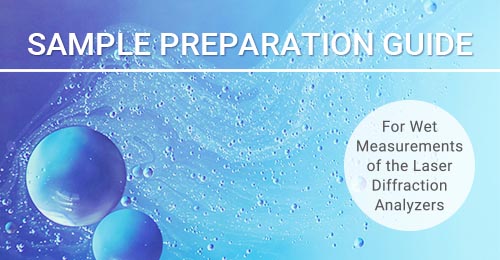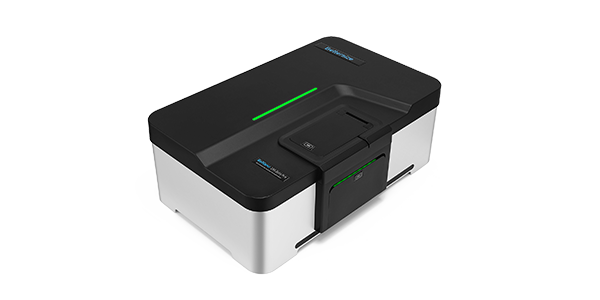BeNano 90 Zeta
The BeNano Series is the latest generation of nanoparticle size and zeta potential analyzers designed by Bettersize Instruments. Dynamic light scattering (DLS), electrophoretic light scattering (ELS), and static light scattering (SLS) are integrated into the system to provide accurate measurements on particle size, zeta potential, and molecular weight. The BeNano Series is widely applied in academic and manufacturing processes of various fields including but not limited to: chemical engineering, pharmaceuticals, food and beverage, inks and pigments, and life science, etc.
Features and Benefits
- ● Size range: 0.3nm - 15μm
- ● Minimum sample volume 3μL
- ● APD (Avalanche Photodiode) detector providing exceptional sensitivity
- ● Automatic adjustment of laser intensity
- ● Intelligent algorithm of result evaluation
- ● PALS (Phase Analysis Light Scattering) technology
- ● Programmable temperature control system
- ● Compliance with 21 CFR Part 11, ISO 22412, ISO 13099
Video
Bettersize BeNano Launch Event | Nanoparticle size and zeta potential analyzer 
Product launch event - Nanoparticle analyzer on March 10th! BeNano Teaser 
BeNano 90 Zeta | Nanoparticle size and zeta potential analyzer 
Fundamentals of BeNano 90 Zeta 
BeNano 90 Zeta | Demo (Polystyrene Standard Sample) 
4 Questions Nanoparticle Researchers are Really Asking About 
Overview
1) Optical Layout of the BeNano 90 Zeta

Dynamic light scattering (DLS), also known as photon correlation spectroscopy (PCS) or quasi-elastic light scattering (QELS), is a technology used to detect the fluctuations of the scattering intensities caused by the Brownian motion of particles.

In the dispersant, smaller particles move faster, while larger particles move slower. An avalanche photodiode (APD) detector aligned at 90°collects the scattering intensities of the particles and records them with time. The time-dependent fluctuation is converted into a correlation function using the correlator. By applying a mathematic algorithm, the diffusion coefficient D is thereby obtained. The hydrodynamic diameter DH and its distribution are calculated through the Stokes-Einstein equation.

3) Electrophoretic Light Scattering
Particles usually carry charges on the surface in aqueous systems, surrounded by counter-ions that form a firmly inner Stern layer and an outer shear layer. Zeta potential is the electrical potential at the interface of the shear layer. Suspension systems with higher zeta potentials tend to be more stable and less likely to form aggregates.
Electrophoretic light scattering (ELS) is a technology for measuring electrophoretic mobility via Doppler shifts of the scattered light. When an incident light illuminates dispersed particles that are subjected to an applied electric field, the frequency of the particles' scattered light will be different from the incident light due to the Doppler effect. The frequency shift is measured and converted to provide the electrophoretic mobility and hence the zeta potential of a sample by Henry's equation.



Static light scattering (SLS) is a technology that measures the scattering intensities of the sample, weight-average molecular weight (Mw), and second virial coefficient A2 through the Rayleigh equation:

where c is the sample concentration, θ is the detection angle, Rθ is the Rayleigh ratio used to characterize the intensity ratio between the scattered light and the incident light at angle θ, Mw is the sample’s weight-average molecular weight, A2 is the second virial coefficient, and K is a constant related to (dn/dc)2.
During molecular weight measurements, scattering intensities of the sample at different concentrations are detected. By using the scattering intensity and Rayleigh ratio of a known standard (such as toluene), the Rayleigh ratios of samples at different concentrations are computed and plotted into a Debye plot. The molecular weight and the second virial coefficient are then obtained through the intercept and slope from the linear regression of the Debye plot.


5)Phase Analysis Light Scattering (PALS)
The traditional ELS converts the correlated scattering signals into frequency distribution and then calculates the frequency shift Δf of the scattered light, compared with the reference light. Phase analysis light scattering (PALS), an advanced technology based on the traditional ELS technology, has been further developed by Bettersize Instruments Ltd. to measure zeta potential and its distribution of a sample. By analyzing the phase information Φ of the original scattered signal, PALS obtains the frequency information of that light. The phase shift with time dΦ/dt is proportional to the frequency shift Δf. PALS technology can suppress the influence of the Brownian motion of particles on the results, thereby providing higher statistical accuracy. In various applications, PALS can effectively measure the zeta potential of particles whose charge approaches the isoelectric point, for instance, particles with very slow electrophoretic mobility at a high salt concentration.


6) Temperature Trend Measurement
Temperature trend measurement includes:
- Size vs. Temperature
- Zeta Potential vs. Temperature
Investigating the particle size and zeta potential of the samples under different temperatures is significant in many applications. The function of Programmed Temperature Change, ranging from -10°C to 110°C, makes Temperature Trend Measurement available in the BeNano Series.

Benefits
- This feature benefits users who need to study the stability of protein formulations. Generally, the higher the denaturation temperature of the protein, the more stable the formulation.
- Besides, it is useful for users who need to simulate real-time aging using elevated temperatures to manually speed up the aging process.
7) Viscosity Measurement
For the sample of unknown viscosity, the viscosity measurement could be implemented using tracer particles with known sizes (e.g., standard samples with nominal sizes). When the measurement ends, input the accurate size of the tracer particles, and the viscosity of the sample could be determined.
After the measurement, choose and right-click on the corresponding result. Click "Viscosity Calculator" on the pop-up menu. By inputting the nominal values of the tracer particles and clicking on "Calculation", the viscosity of the sample could be finally ascertained.

Citations
- Bettersizer 2600
Functional redundancy as an indicator for evaluating functional diversity of macrobenthos under the mussel raft farm near Gouqi Island
DOI: 10.1016/j.aquaculture.2023.740024 Read ArticleZhejiang Ocean University | 2024Biological traits analysis (BTA) helps to evaluate the effects of different environmental variables on the traits-based functional composition of macrobenthos. However, research on functional traits of macrobenthos under mussel farming is limited. We investigated the spatial and temporal response of the benthic system in terms of taxonomic and functional diversity to environmental variables of farming and natural stressors resulting from suspended mussel farming near Gouqi Island of eastern China Sea. The functional traits of macrobenthic assemblages under mussel farming were characterized by “medium adult body size”, “vermiform body form”, “high flexibility”, “infauna”, “semi-motile”, “gonochoristic”, “surface deposit-feeders”, “carnivores”, “semi-motile burrowers”, and “tube-dwellers”. Functional redundancy was stable in response to mussel farming stresses among seasons, whereas species diversity showed efficient to evaluate natural variables. Functional diversity was significantly affected by farming stressors rather than natural variables, Further analysis using multivariate methods together with continuous monitoring were highlighted to evaluate the impacts of mussel farming. Our results reinforce the importance of macrobenthic species and functional traits analysis to evaluate human stresses driven impacts in offshore ecosystems. By analysing the environmental variables with different sources, independently, we concluded the main effects of human pressures on macrobenthic community. Such distinction could be particularly effective to isolate variable environmental descriptors and evaluate their effects on functional diversity, making the current approach promising for the evaluation of ecological effects of anthropogenic stressors in aquaculture areas. - Bettersizer 2600
Degradation characteristics and utilization strategies of a covalent bonded resin-based solid amine during capturing CO2 from flue gas
DOI: 10.1016/j.seppur.2023.125621 Read ArticleChina University of Petroleum | 2024In this study, various types of degradation as well as attrition which are possibly encountered in a circulating fluidized bed temperature swing adsorption (CFB-TSA) process, were conducted experimentally to evaluate the stability of a resin-based solid amine sorbent. Other characterizations methods, such as elemental analysis (EA), Fourier transform infrared spectroscopy (FTIR) etc. were applied to further reveal the degradation mechanisms. The results showed that thermal degradation occurs from 140–160 °C due to the decomposition of amine group. The CO2-induced degradation occurs from a higher temperature of 160–180 °C accompanied by the production of urea. Hydrothermal stability is good below 130 °C, but the ionic impurities in steam crystalized on particle surface can accelerate the degradation. Oxidative degradation is the most harmful, which starts at a lower temperature of 70–80 °C with the formation of aldehyde. The existence of H2O in atmosphere can alleviate the oxidative and CO2-induced degradations. The employed sorbent has a very low attrition index of 0.05, which is 1–2 orders lower than typical commercial fluidized bed catalysts. Based on the results of stability evaluation, some design suggestions for proper utilization of this sorbent or other similar resin-based sorbents have been provided in an industrial CFB-TSA process.
- Bettersizer 2600
De-branching of starch molecules enhanced the complexation with chitosan and its potential utilization for delivering hydrophobic compounds
DOI: 10.1016/j.foodhyd.2023.109498 Read ArticleShihezi University | 2024The current study aimed to prepare the complexes between debranched-waxy corn starch and chitosan polymers (DBS-CS), and then investigated their corresponding structural characteristics, rheological property and potent application in Pickering emulsion. The results indicated that the existence of chitosan significantly inhibited starch short-range molecular rearrangement for all DBS-CS samples, which was manipulated by both debranching treatment and chitosan content. Interestingly, this is the first study to reveal that the outstanding peak at 1.8 ppm in 1H NMR spectrum for sample DBS-CS was gradually shifted towards a lower-field region following an increased chitosan content. Moreover, the debranching treatment shifted the crystallinity pattern from A-type to B-type and the relative crystallinity of DBS-CS decreased gradually with the increased content of CS. All samples had a pseudoplastic fluid and shear-thinning behavior with an enhanced shear resistance following the complexation. The DBS-CS was applied in a Pickering emulsion for showing a greater emulsifying stability and a lower gel strength than native NS-CS prepared emulsion. Importantly, the encapsulation ability of curcumin in the DBS-CS emulsion was significantly improved, followed by an increase of 15.45% for its corresponding bioavailability compared to the control. Therefore, this study might highlight a potential carrier for delivering the bioactive substances in a green pattern. - Bettersizer 2600
Heat-induced aggregation behavior of wheat gluten after adding citrus pectin with different esterification degree
DOI: 10.1016/j.foodhyd.2023.109420 Read ArticleGansu Agricultural University | 2024Wheat gluten aggregation during heat treatment is beneficial to the final quality of gluten-based products. Exogenous pectin can affect gluten aggregation. However, the effect of pectin with different degrees of esterification on the heat-induced aggregation behavior of gluten and its possible mechanism are still unclear. Thus, the heat-induced aggregation behavior of gluten after adding pectin with different esterification degree was studied in this study. When the temperature was raised from 25 °C to 95 °C, pectin affected gluten aggregation and was related to the degree of esterification. Specifically, the results of rheological properties and particle size indicated that low-ester pectin improved the viscoelasticity of gluten and promoted gluten aggregation. Thermal properties revealed that enthalpy of gluten added with low-ester pectin (37%) increased from 92.96 J/g to 95.40 J/g during heating process. Structurally, the fluorescence intensity and surface hydrophobicity of gluten added with low-ester pectin (37%) were lower than those added with high-ester pectin (73%). In addition, low-ester pectin (37%) significantly increased the disulfide bond content (from 15.31 μmol/g to 18.06 μmol/g) and maintained β-sheet content of gluten compared with gluten alone at 95 °C, indicating that low-ester pectin was more likely to induce gluten aggregation. However, scanning electron microscope showed that the gluten added with low-ester pectin (46%) exhibited a denser network structure at 95 °C than that added with low-ester pectin (37%). These results will provide a theoretical base for the regulation of gluten aggregation and the quality of gluten-based products by pectin with different esterification degree.
- 1
- 2
- 3
- 4
- 5
- 6
- 84
Curated Resources
- Guidebook
 bigClick
bigClick2023-03-09
Sample preparation guide for wet measurement using the laser diffraction particle size analyzer
- Guidebook
 bigClick
bigClick2023-01-16
A Practical Guide to Nanoparticle Characterization by Light Scattering Techniques
- Application Note
 bigClick
bigClick2021-03-03
Measuring the Size of Self-Assembled Surfactant Micelles at Different Temperatures and Concentrations
Related Nanoparticle Size and Zeta Potential Analyzer
-
BeNano 180 Zeta Pro
Nanoparticle Size and Zeta Potential Analyzer
Technology: Dynamic Light Scattering, Electrophoretic Light Scattering, Static Light Scattering

















